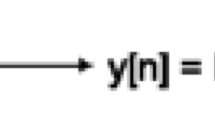Abstract
A current-mode reconfigurable architecture for M-point discrete Fourier transform with a complex vector-matrix multiplication method has been presented along with a signal routing algorithm. The circuit for DFT computation of any length can be modeled using this approach. It provides improved performance over other analog circuits using divide-and-conquer algorithms. This architecture consists of two stages: a switched current mirror replicator (SCMR) and the reconfigurable vector-matrix multiplier (VMM). With the analog–digital combined multiplier tuning, precise computation becomes possible. The novel graph-based signal routing algorithm has been proposed to manage multiplier resources efficiently. During 16-point DFT processing, the average accuracy of about \(\pm 0.7\%\) was found at the power consumption of 28.3mW with a processing delay of 4.9\(\mu \)s. The architecture has been modeled with a 65nm CMOS process operating at a 1V power supply.













Similar content being viewed by others
Data Availability
This article does not include any specific data set for the validation of proposed theoretical model. However, data generated from the analysis/computation may be made available by the corresponding author on request.
References
V. Ariyarathna, A. Madanayake, X. Tang, D. Coelho, R.J. Cintra, L. Belostotski, S. Mandal, T.S. Rappaport, Analog approximate-FFT 8/16-beam algorithms, architectures and CMOS circuits for 5G beamforming MIMO transceivers. IEEE J. Emerg. Select. Topics Circ. Syst. 8(3), 466–479 (2018). https://doi.org/10.1109/jetcas.2018.2832177
H.F. Baghtash, Body controlled threshold voltage shifting variable gain current mirror. Analog Integr. Circ. Signal Process. 93(1), 115–121 (2017). https://doi.org/10.1007/s10470-017-1030-3
M. Bhanja, B. Ray, A graph based synthesis procedure for linear analog function. In: 2017 30th IEEE International System-on-Chip Conference (SOCC) (2017). https://doi.org/10.1109/SOCC.2017.8226071
K. Boyle, P. Mercier, N. Sadeghi, V. Gaudet, C. Schlegel, C. Winstead, M. Kashyap, Design and implementation of an all-analog fast Fourier transform processor. In: 2007 50th Midwest Symposium on Circuits and Systems (2007). https://doi.org/10.1109/mwscas.2007.4488832
A. Ganguly, A. Chakraborty, A. Banerjee, A novel VLSI design of Radix-4 DFT in current mode. Int. J. Electron. (Taylor and Francis) 106(12), 1845–1863 (2019). https://doi.org/10.1080/00207217.2019.1625972
I. J. Good, Introduction to Cooley and Tukey (1965) An Algorithm for the Machine Calculation of Complex Fourier Series, Springer Series in Statistics Breakthroughs in Statistics, 201–216 (1997)
X. Guo, F.M. Bayat, M. Bavandpour, M. Klachko, M.R. Mahmoodi, M. Prezioso, K.K. Likharev, D.B. Strukov, Fast, energy-efficient, robust, and reproducible mixed-signal neuromorphic classifier based on embedded NOR flash memory technology. In: 2017 IEEE International Electron Devices Meeting (IEDM), 6.5.1–6.5.4 (2017). https://doi.org/10.1109/iedm.2017.8268341
M. Kato, T. Adachi, T. Tanaka, A shallow-trench-isolation flash memory technology with a source-bias programming method. In: International Electron Devices Meeting. Technical Digest, 177–180 (1996). https://doi.org/10.1109/IEDM.1996.553148
S. Kawahito, M. Yoshida, M. Sasaki, K. Umehara, D. Miyazaki, Y. Tadokoro, K. Murata, S. Doushou, A. Matsuzawa, A CMOS image sensor with analog two-dimensional DCT-based compression circuits for one-chip cameras. IEEE J. of Solid-State Circ. 32(12), 2030–2041 (1997). https://doi.org/10.1109/4.643661
K. Kleine, J.H. Reed, A.J. Michaels, A 256-point analog discrete-time FFT. In: 2020 IEEE 63rd International Midwest Symposium on Circuits and Systems (MWSCAS), 966–969 (2020). https://doi.org/10.1109/mwscas48704.2020.9184511
M. Kurnaz, S. Minaei, I.C. Goknar, Time delay calculation in current-mode circuits. In: 2013 8th International Conference on Electrical and Electronics Engineering (ELECO), 349–352 (2013). https://doi.org/10.1109/ELECO.2013.6713859
M. Lehne, S. Raman, A 0.13-\(\mu {\text{m}}\) 1-GS/s CMOS discrete-time FFT processor for ultra-wideband OFDM wireless receivers. IEEE Trans. Microwave Theory Tech. 59(6), 1639–1650 (2011). https://doi.org/10.1109/tmtt.2011.2132733
A. Mishra, M.V. Bhat, P.K. Pai, D.V. Kamath, Implementation of low voltage floating gate MOSFET based current mirror circuits using 180 nm technology, in 2019 Third International Conference on Inventive Systems and Control (ICISC), 268–272 (2019). https://doi.org/10.1109/ICISC44355.2019.9036355
M. Meissner, L. Hedrich, FEATS: framework for explorative analog topology synthesis. IEEE Trans. Comput.-Aid. Des. Integr. Circ. Syst. 34(2), 213–226 (2015). https://doi.org/10.1109/TCAD.2014.2376987
D. Navarro, O. Lucia, L.A. Barragan, I. Urriza, O. Jimenez, High-level synthesis for accelerating the FPGA implementation of computationally demanding control algorithms for power converters. IEEE Tran. Ind. Inform. 9(3), 1371–1379 (2013). https://doi.org/10.1109/TII.2013.2239302
M. Nouri, M. Hayati, T. Serrano-Gotarredona, D. Abbott, A digital neuromorphic realization of the 2-D Wilson neuron model. IEEE Trans. Circ. Syst. II Express Briefs 66(1), 136–140 (2019). https://doi.org/10.1109/TCSII.2018.2852598
M. Paliy, S. Strangio, P. Ruiu, T. Rizzo, G. Iannaccone, Analog vector-matrix multiplier based on programmable current mirrors for neural network integrated circuits. IEEE Access 8, 203525–203537 (2020). https://doi.org/10.1109/access.2020.3037017
M. Pankaala, K. Virtanen, A. Paasio, An analog 2-D DCT processor. IEEE Trans. Circ. Syst. Video Technol. 16(10), 1209–1216 (2006). https://doi.org/10.1109/tcsvt.2006.882392
P.G. Reshma, V.P. Gopi, V. Suresh Babu, K.A. Wahid, Analog CMOS implementation of FFT using Cascode current mirror. Microelectron. J. 60, 30–37 (2017). https://doi.org/10.1016/j.mejo.2016.12.002
K.H. Rosen, Discrete Mathematics and Its Applications (McGraw-Hill, New York, 1999)
N. Sadeghi, V.C. Gaudet, C. Schlegel, Analog DFT processors for OFDM receivers: circuit mismatch and system performance analysis. IEEE Trans. Circ. Syst. I Regular Pap. 56(9), 2123–2131 (2009). https://doi.org/10.1109/tcsi.2008.2011582
B. Sadhu, M. Sturm, B.M. Sadler, R. Harjani, Analysis and design of a 5 GS/s analog charge-domain FFT for an SDR front-end in 65 nm CMOS. IEEE J. Solid-State Circ. 48(5), 1199–1211 (2013). https://doi.org/10.1109/jssc.2013.2250457
P. Sniatala, A. Handkiewicz, M. Naumowicz, S. Szczesny, M. Melosik, P. Katarzynski, M. Kropidlowski, Automated design of switched current sigma-delta modulator with a new comparator structure. In: Proceedings of the 20th International Conference Mixed Design of Integrated Circuits and Systems - MIXDES 2013, (2013)
S. Suh, A. Basu, C. Schlottmann, P.E. Hasler, J.R. Barry, Low-power discrete Fourier transform for OFDM: a programmable analog approach. IEEE Trans. Circ. Syst. I Regular Pap. 58(2), 290–298 (2011). https://doi.org/10.1109/tcsi.2010.2071950
Y. Yang, H. Zhu, Z. Bi, C. Yan, D. Zhou, Y. Su, X. Zeng, Smart-MSP: a self-adaptive multiple starting point optimization approach. IEEE Trans. Comput.-Aid. Des. Integr. Circ. Syst. 37(3), 531–544 (2018). https://doi.org/10.1109/TCAD.2017.2729461
CMOS Substrate Biasing for Threshold Voltage Control, by T. Yamauchi, and K. Arimoto (1998, Nov. 17). US5838047A. Accessed on: May. 2, 2021. [Online]. Available: https://patents.google.com/patent/US5838047A/en
G. Zwicker, P. Lange, P. Staudt-Fischbach, W. Windbracke, Field isolation using shallow trenches for submicron CMOS technology. In: ESSDERC ’89: 19th European Solid State Device Research Conference, 147–150 (1989). https://doi.org/10.1007/978-3-642-52314-4_29
Acknowledgements
The authors would like to thank MHRD, Govt. of India, for sponsoring this research Work.
Author information
Authors and Affiliations
Corresponding author
Additional information
Publisher's Note
Springer Nature remains neutral with regard to jurisdictional claims in published maps and institutional affiliations.
Rights and permissions
About this article
Cite this article
Ganguly, A., Banerjee, A. A Novel Reconfigurable Analog VLSI Architecture of M-point DFT Using Complex Matrix Multiplier and Graph-Based Signal Routing Method. Circuits Syst Signal Process 41, 5201–5225 (2022). https://doi.org/10.1007/s00034-022-02030-6
Received:
Revised:
Accepted:
Published:
Issue Date:
DOI: https://doi.org/10.1007/s00034-022-02030-6




